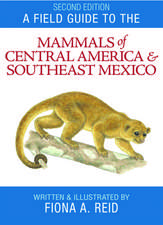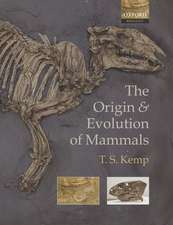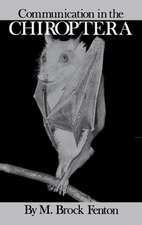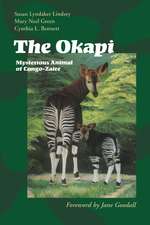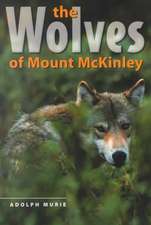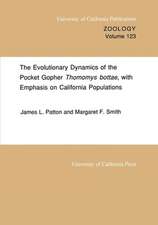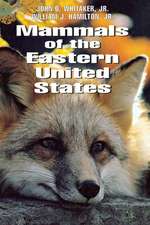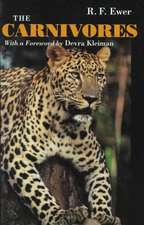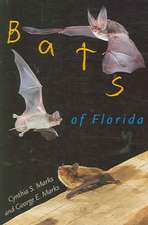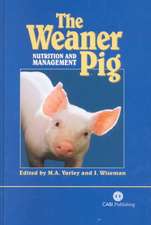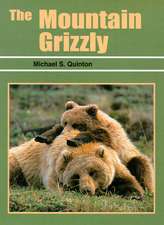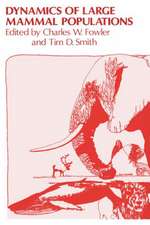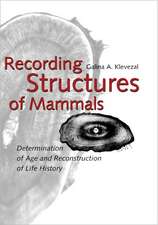Bats: From Evolution to Conservation
Autor John D. Altringhamen Limba Engleză Paperback – 25 aug 2011
| Toate formatele și edițiile | Preț | Express |
|---|---|---|
| Paperback (1) | 430.47 lei 31-37 zile | |
| Oxford University Press – 25 aug 2011 | 430.47 lei 31-37 zile | |
| Hardback (1) | 854.50 lei 31-37 zile | |
| OUP OXFORD – 24 aug 2011 | 854.50 lei 31-37 zile |
Preț: 430.47 lei
Preț vechi: 547.58 lei
-21% Nou
Puncte Express: 646
Preț estimativ în valută:
82.38€ • 85.69$ • 68.01£
82.38€ • 85.69$ • 68.01£
Carte tipărită la comandă
Livrare economică 04-10 aprilie
Preluare comenzi: 021 569.72.76
Specificații
ISBN-13: 9780199207121
ISBN-10: 0199207127
Pagini: 352
Ilustrații: Over 200 illustrations, plus an 8 page colour plate section
Dimensiuni: 189 x 246 x 19 mm
Greutate: 0.78 kg
Ediția:Revised
Editura: Oxford University Press
Colecția OUP Oxford
Locul publicării:Oxford, United Kingdom
ISBN-10: 0199207127
Pagini: 352
Ilustrații: Over 200 illustrations, plus an 8 page colour plate section
Dimensiuni: 189 x 246 x 19 mm
Greutate: 0.78 kg
Ediția:Revised
Editura: Oxford University Press
Colecția OUP Oxford
Locul publicării:Oxford, United Kingdom
Recenzii
Review from previous edition A valuable addition to the bat library of enthusiasts and professionals, this book gives up-to-date discussions on the special features of bats world-wide and their place in a modern biological context ... this is a good fresh look at fascinating aspects of bat biology and behaviour.
a useful reference for everyone from professional biologists to persons simply interested in learning more about the biology of bats ... I greatly enjoyed reading this book; it is an excellent contribution to the literature on the biology of bats. In addition to providing a useful account of the biology of the world's bats, the author has used bats to demonstrate how basic biological processes also shape the rest of our natural world. I believe this book is a valuable reference for bat enthusiasts ... and I highly recommend it to anyone interest in the biology of mammals.
The book is richly illustrated with drawings, graphs and tables that augment information presented in the text. The wealth of unanswered questions about bats emerges from the book, making it easy for student readers to see and appreciate the opportunities that bats present to a variety of biologists. This is an excellent book from one end to the other and I highly recommend it to students and colleagues. It is a book that meets its stated goal ... to use bats to illustrate processes and concepts in biology. When it comes to ecology and behaviour, he has more than succeeded ... Bravo!
Not a casual coffee-table book and not a beginner's guide, this book is aimed at students ... it is a surprisingly readable, yet highly scientific, description of bat flight ... If you want to take an active part in bat conservation, you'll be much better informed by this book.
this book provides an up-to-date and accurate picture of how bats spend their lives and will be an indispensable reference work for both professional and amateur naturalists
...this is an excellent book for people with a genuine interst in bats...This will be an essential reference for bat enthusiasts...
...interesting and readable book...Altringham's conversational writing style makes the book very readable, and he is genuinely fascinated by his topic...an interesting and enjoyable reference for students and scientists with an interest in bats.
This book on the natural history and biology of bats is aimed primarily at zoology students but will also appeal to many amateur naturalists...The book is well illustrated and well referenced.
a useful reference for everyone from professional biologists to persons simply interested in learning more about the biology of bats ... I greatly enjoyed reading this book; it is an excellent contribution to the literature on the biology of bats. In addition to providing a useful account of the biology of the world's bats, the author has used bats to demonstrate how basic biological processes also shape the rest of our natural world. I believe this book is a valuable reference for bat enthusiasts ... and I highly recommend it to anyone interest in the biology of mammals.
The book is richly illustrated with drawings, graphs and tables that augment information presented in the text. The wealth of unanswered questions about bats emerges from the book, making it easy for student readers to see and appreciate the opportunities that bats present to a variety of biologists. This is an excellent book from one end to the other and I highly recommend it to students and colleagues. It is a book that meets its stated goal ... to use bats to illustrate processes and concepts in biology. When it comes to ecology and behaviour, he has more than succeeded ... Bravo!
Not a casual coffee-table book and not a beginner's guide, this book is aimed at students ... it is a surprisingly readable, yet highly scientific, description of bat flight ... If you want to take an active part in bat conservation, you'll be much better informed by this book.
this book provides an up-to-date and accurate picture of how bats spend their lives and will be an indispensable reference work for both professional and amateur naturalists
...this is an excellent book for people with a genuine interst in bats...This will be an essential reference for bat enthusiasts...
...interesting and readable book...Altringham's conversational writing style makes the book very readable, and he is genuinely fascinated by his topic...an interesting and enjoyable reference for students and scientists with an interest in bats.
This book on the natural history and biology of bats is aimed primarily at zoology students but will also appeal to many amateur naturalists...The book is well illustrated and well referenced.
Notă biografică
John Altringham is Professor of Animal Ecology and Conservation at the University of Leeds, UK, where he has been since 1989. He completed his BSc at the University of York, and his PhD at St. Andrews University, where he returned as a research fellow from 1983-1989. During his career he has travelled widely, studying animals as varied as tuna fish and tarantulas before focusing on bat ecology and conservation. He has published over 100 scientific papers, numerous book chapters, and two previous books: Bats: Biology and Behaviour (OUP, 1996), and British Bats (Harper Collins, 2003). He is also a regular advisor and contributor to BBC Natural History Unit productions for TV and radio, and is a member of a number of conservation advisory groups, including the Nature Conservation Panel of the National Trust. John lives on the edge of the Yorkshire Dales with his wife, Kate, and two children, Alex and Anne.

